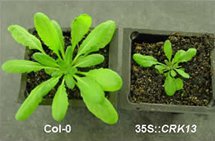Ramesh Raina

Ramesh Raina
Professor
CONTACT
Biology
464 Life Sciences Complex
Email: raraina@syr.edu
Office: 315.443.4546
PROGRAM AFFILIATIONS
Biochemistry
Biophysical Science
Biotechnology
Degrees
- Ph.D., Jawaharlal Nehru University (1991)
- Postdoctoral Fellow, Carnegie Institute of Washington (1992-1995)
Social/Academic Links
Courses Taught
- BIO 400/600 Modern Concepts in Biology
- BIO 462 Molecular Genetics
- BIO 465/665 Molecular Biology Lab
- BIO 787 Functional Genomics
Epigenetic mechanisms regulating plant defense against pathogens and plant development.
Research Spotlight

The overall goal of the Raina Lab is to understand how plants sense the environment and activate defense against pests. We use genetic and molecular approaches to identify the genes involved in these processes and the molecular mechanisms regulating the responses. Our lab is currently pursuing the following specific projects: genetic and molecular mechanisms regulating plant-pathogen interaction, and functional genomics of cell signaling in plants.
Structural Biology, Biochemistry, and Biophysics Program
Member of the Core Faculty of the Renée Crown Honors Program at Syracuse University
- Caruana J., Dhar N., R. Raina (2020) Overexpression of Arabidopsis microRNA167 induces salicylic acid-dependent defense against Pseudomonas syringae through the regulation of its targets ARF6 and ARF8. Plant Direct. 2020;00:1–16. https://doi.org/10.1002/pld3.270
- Dhar N., Caruana J., Erdem I., Raina R. (2020) An Arabidopsis DISEASE RELATED NONSPECIFIC LIPID TRANSFER PROTEIN 1 (DRN1) is required for resistance against various phytopathogens and tolerance to salt stress. GENE, https://doi.org/10.1016/j.gene.2020.144802.
- Dutta, A., Choudhary, P., Gupta, P., Chatterjee, S., Liu, Po-Pu, Klessig, D. F., Raina, R. (2020) Arabidopsis SMALL DEFENSE-ASSOCIATED PROTEIN 1 modulates pathogen defense and tolerance to oxidative stress. Front. Plant Sci., doi: 10.3389/fpls.2020.00703.
- Dhar, N., Caruana, J., Erdem, I., Subbarao, K. V., Klosterman, S. J., and Raina, R. (2020) The Arabidopsis SENESCENCE ASSOCIATED GENE 13 regulates dark-induced senescence and plays contrasting roles in the defense against bacterial and fungal pathogens. MPMI https://doi.org/10.1094/MPMI-11-19-0329-R.
- Li D., Liu R., Singh D., Yuan X., Kachroo P. and Raina, R. (2020) JMJ14 encoded H3K4 demethylase modulates immune responses by regulating defence gene expression and pipecolic acid levels. New Phytologist 225: 2108-2121. https://doi.org/10.1111/nph.16270
- Twyford AD, Caola AM, Choudhary P, Raina R, Friedman J (2018) Loss of color pigmentation is maintained at high frequency in a monkey flower population. The American Naturalist 191: 135-145.
- Dutta, A., Choudhary, P., Caruana, J. C. and Raina, R. (2017) JMJ27, an Arabidopsis H3K9 histone demethylase, modulates defense against Pseudomonas syringae and flowering time. Plant J. 91: 1015-1028.
- Xiao Y, Choudhary, P., Mehrotra, K., Mohan, C. and Raina, R. (2017) Identification of biological functions by combinatorial histone patterns profiling. Proceedings of the 9th International Conference on Bioinformatics and Computational Biology, BICoB–2017: 217-222.
- Ritchie, M. and Raina, R. (2016) Effects of herbivores on nitrogen fixation in soil and by a dominant grass and legume in the Serengeti. Pedobiologia 59: 233-241.
- Lundgren B. R., Connolly M. P., Choudhary P., Brookins-Little T. S., Chatterjee S., Raina R. and Nomura, C. T. (2015) Defining the metabolic functions and roles in virulence of the rpoN1 and rpoN2 genes in Ralstonia solanacearum GMI1000. PLOS ONE. DOI:10.1371/journal.pone.0144852.
- Dutta A., Chan S.H.P., Pauli N.T., R. Raina (2015). HYPERSENSITIVE RESPONSE-LIKE LESIONS 1 codes for AtPPT1 and regulates accumulation of ROS and defense against bacterial pathogen Pseudomonas syringae in Arabidopsis thalaina. Antioxid Redox Signal. DOI:10.1089/ars.2014.5963.
- Appel H.M., Maqbool S.B., Raina S., Jagadeeswaran G., Acharya B.R., Hanley J.C. Jr., Miller K.P., Hearnes L., Jones A.D., Raina R., J.C. Schultz (2014). Transcriptional and metabolic signatures of Arabidopsis responses to chewing damage by an insect herbivore and bacterial infection and the consequences of their interaction. Front. Plant Sci., doi: 10.3389/fpls.2014.00441.
- Alobaid, F., Mehrotra, K., Mohan, C., and R. Raina (2012) SMAlign: Alignment of DNA sequences with gap constraints. 4th International Conference on Bioinformatics and Computational Biology, BICoB–2012: 43-50.
- Springer, D.J., Ren, P., Raina, R., Dong, Y., Behr, M.J., McEwen, B. F., Bowser, S., Samsonoff, W., Chaturvedi, S., and V. Chaturvedi (2010) Extracellular fibrils of pathogenic yeast Cryptococcus gattii are important for ecological niche, murine virulence and human neutrophil interactions. PloS One 5:e10978.
- Jagadeeswaran G., S. Raina, B. R. Acharya, S. B. Maqbool, S. L. Mosher, H. M. Appel, J. C. Schultz, D. F. Klessig and R. Raina (2007) Arabidopsis GH3-LIKE DEFENSE GENE 1 is required for accumulation of salicylic acid, activation of defense responses and resistance to Pseudomonas syringae. Plant J. 51: 234-46.
- Acharya, B. R., S. Raina, S. B. Maqbool, G. Jagadeeswaran, S. L. Mosher, H. M. Appel, J. C. Schultz, D. F. Klessig and R. Raina (2007) Overexpression of CRK13, an Arabidopsis cysteine-rich receptor-like kinase, results in enhanced resistance to Pseudomonas syringae. Plant J. 50: 488-49.
- Mahalingam, R., A. M. Gomez-Buitrago, N. Eckardt, N. Shah, A. Guevara-Garcia, P. Day, R. Raina* and N. Fedoroff* (2003). Characterization of stress/defense transcriptome of Arabidopsis. Genome Biology 4:R20 (*corresponding authors).
- Devadas, S. K., A. Enyedi and R. Raina (2002). The Arabidopsis hrl1 mutation reveals novel overlapping roles of salicylic acid, jasmonic acid, and ethylene signaling in cell death and defense against pathogens. Plant J. 30: 467-480.
- Devadas, S. K. and R. Raina (2002). Preexisting systemic acquired resistance suppresses hypersensitive response-associated cell death in Arabidopsis hrl1mutant. Plant Physiol. 128:1234-1244.
- Pilloff, R. K., S. K. Devadas, A. Enyedi, and R. Raina (2002). The Arabidopsis gain-of-function mutant dll1 spontaneously develops lesions mimicking cell death associated with disease. Plant J. 30:61-70.
(April 28, 2016)
Raina, Scott Honored for Work with Graduate Students
(April 27, 2016)
Snigdha Chatterjee ’17 granted competitive travel grant and summer fellowship
